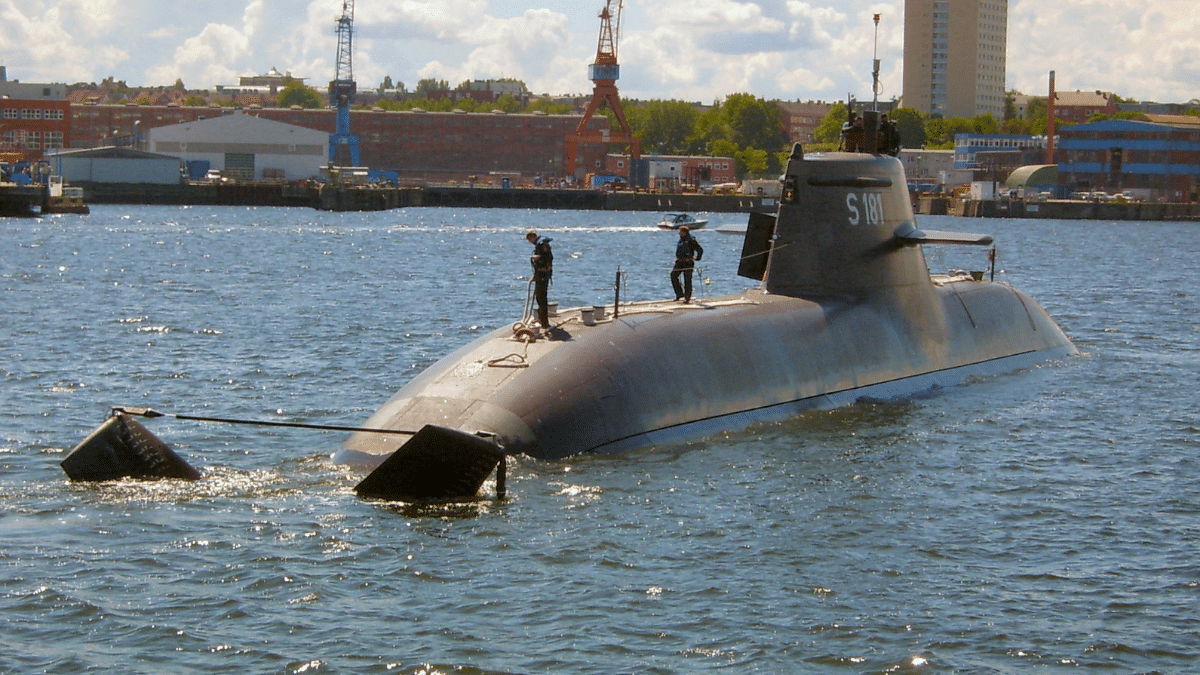 Image Credits - Wikipedia
Image Credits - Wikipedia
The first submarine of the Type 212A class, U-31 (S181), is a symbol of German naval strength. U-31 was launched into the sea on March 20, 2002. It was built by ThyssenKrupp Marine Systems (TKMS) at the shipyards of Thyssen Nordseewerke in Emden and Howaldtswerke in Kiel.
General Characteristics:
Part of the Type 212 class, the German submarine U-31 (S181) is intended for both surface and underwater missions. It has a length of 56 metres (183.7 feet) and a width of 7 metres (22.96 feet), with a displacement of 1,450 tonnes when surfaced and 1,830 tonnes while submerged. With a length of 57.2 metres (187.66 ft), the second batch of U-31 is slightly longer. It has a 6-metre (19.68-foot) draft.
The MTU-396 16V diesel engine, which produces 2,150 kW, and the Siemens Permasyn electric motor Type FR6439-3900KW, which produces 2,850 kW, together power the submarine. One MTU 16V 396 diesel engine, one 1700 kW Siemens Permasyn electric motor, and nine HDW/Siemens PEM fuel cells—whose power outputs vary based on the batch—make up the propulsion system.
Impressive performance qualities allow U-31 to reach a submerged speed of 20 knots (37 km/h) and a surface speed of 12 knots. When travelling at 8 knots (15 km/h) on the surface, it can cover 8,000 nautical miles (14,800 km) and last for three weeks without snorkelling, for a total endurance of 12 weeks. The submarine’s sturdy design is demonstrated by its test depth of over 700 metres (2,296 ft).
There are five officers and twenty-two enlisted people on U-31’s crew. The submarine is outfitted with sophisticated sensors and processing equipment, such as Radar: Kelvin Hughes Type 1007 I-band navigation, Sonar: ISUS90-20, and CSU 90 (DBQS-40FTC). Decoys and electronic warfare are controlled by the EADS FL 1800U suite.
U-31 is equipped with two groups of three forward-facing 533 mm torpedo tubes as its armament. It can carry a wide range of weapons, such as up to 24 external naval mines in an optional configuration, 13 DM2A4 and A184 Mod.3 torpedoes, Black Shark torpedoes, and IDAS missiles. Due to its advantages, the submarine is a very effective and adaptable tool in naval operations.
History:
Built-in two pieces for maximum efficiency, the U-31 (S181) was a powerful German submarine of the Type 212A class. Nordseewerke in Emden made the stern and propulsion parts, and Howaldtswerke-Deutsche Werft in Kiel meticulously constructed the bow. A modern submarine with increased underwater capabilities and stealth was created by the smooth integration of these elements.
U-31 and U-32 were both commissioned on October 19, 2005, and they both went into service at Eckernförde in a joint ceremony. Vice-Admiral Wolfgang E. Nolting, the Inspector of the Navy, and Defence Minister Peter Struck oversaw the formal induction of these submarines into the German Navy’s fleet. The commissioning ceremony marked the end of its planning and building and indicated that U-31 was ready for operational service.
With its state-of-the-art fuel cell system, U-31 could stay underwater for a whopping three weeks. The submarine was incredibly elusive and practically undetected during underwater missions because of the integration of stealth skin. In addition to increasing operating longevity, the improved fuel cells also helped to preserve the environment. U-31 produced almost no heat, noise, or exhaust fumes at all, with the only result being distilled water. This almost emission-free performance improved the U-31’s stealth.
Embedded in the 1st Ubootgeschwader (1st Submarine Squadron) of Einsatzflottille 1 after being assigned to Eckernförde, U-31 and its sister ships played fundamental roles. Their role in defending and protecting marine interests was underscored by this strategic positioning. U-31 demonstrated the operational excellence and technological improvements of the Type 212A class submarines while serving as a member of the German Navy’s submarine force, thereby enhancing the country’s strengths in maritime security and defence.
